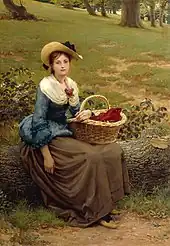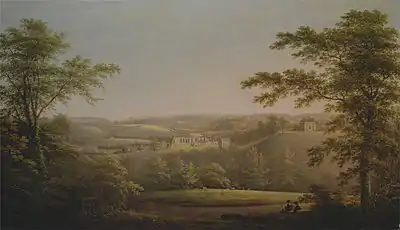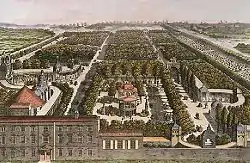The Lass of Richmond Hill
"The Lass of Richmond Hill", also known as "The Sweet Lass of Richmond Hill", is a song written by Leonard McNally with music composed by James Hook, and was first publicly performed in 1789. It was said to be a favourite of George III and, at one time, was thought to have been written by his son, George IV. It is a love ballad which popularized the poetic phrase "a rose without a thorn" as a romantic metaphor. Associated with the English town of Richmond in North Yorkshire, it is now often mistakenly considered to be a traditional folk song, and has been assigned the number 1246 on the Roud Folk Song Index. The music is also used as a military march by the British army.

Lyric
The words were written by Leonard McNally[1][2] (1752 – 1820[3]), who was a Dublin barrister, playwright, a leader of the United Irishmen (a clandestine republican Irish revolutionary society[4]), but also a double agent for the British Government.[5][6] McNally would betray his United Irishmen colleagues to the authorities and then, as defence counsel at their trial, secretly collaborate with the prosecution to secure a conviction.[7][8][9] He wrote a number of songs and operettas, including for Covent Garden.[2]

The "lass" referred to is Frances I’Anson, whom Leonard McNally married in 1787.[2][10] Her family owned a property in Richmond, Yorkshire called "Hill House", hence she was the "lass of Richmond Hill".[2] (Lass is a Scottish or Northern English dialect word for "girl" or "young woman", derived from Old Norse.[11]) Frances's father disapproved of McNally and the couple had to elope in order to marry.[10] She died in childbirth five years after getting married; she was 29.[10][12]
McNally's authorship was periodically disputed[13] and other origins for the song were claimed over the years.[14] These claims included that it was written by a Rosa Smith, who may have been a poet from Richmond, Surrey near London, and that it was about herself; that it was the work of another songwriter called Upton; and that the Prince of Wales (who later became the Prince Regent and then George IV) was the author.[14] It was also thought that the Prince of Wales's mistress, Maria Fitzherbert ("Mrs Fitzherbert") was the subject of the song.[15] All of these claims were unfounded.[14]
The song is a ballad of praise of and expression of love for the "lass". It contains two verses with eight lines each and a chorus of four lines repeated after each verse. The first verse begins with the notable lines:[16]
.jpg.webp)
- On Richmond Hill there lives a lass,
- More bright than May-day morn,
- Whose charms all other maids' surpass,
- A rose without a thorn.
The chorus is:
- Sweet lass of Richmond Hill,
- Sweet lass of Richmond Hill,
- I'd crowns resign to call thee mine,
- Sweet lass of Richmond Hill.
According to the musicologist and conductor Peter Holman, "a way of celebrating national identity was to place a love-story in a picturesque British rural setting. The most famous song of this type is James Hook’s The Lass of Richmond Hill"[17] The song was seen as so quintessentially English that authorship by an Irishman, that is, by McNally, was, as mentioned earlier, periodically challenged.[13]
Music
The music was composed by James Hook (1746 – 1827), a composer and organist at Vauxhall Gardens from 1774 to 1820.[1][18] Hook composed over 2,000 songs, the best known of which is "The Lass of Richmond Hill".[18]
The music epitomises Hook’s charming but sanitised folk-song style using a Scottish pastoral idiom, and is often mistakenly believed to be a genuine traditional folk song,[19][20] and has been assigned the number 1246 on the Roud Folk Song Index.[21] Indeed, it has become a Scottish country dance.[22]
History and cultural references to the song

The song was first performed publicly by Charles Incledon at Vauxhall Gardens in 1789, although McNally appears to have written the words long before that.[2] It became one of the most popular songs of the time,[23] and was said to be a favourite of George III.[24] The song remains popular,[13] and, for example, is played by the BBC's classical music station, Radio 3.[25]
As well as becoming a Scottish country dance,[22] the music has been used as a military march by the British army and is the Regimental march of the Women’s Royal Army Corps[26] and the Middlesex Yeomanry.[27] It was also the march of the 107th Regiment of Foot (Bengal Light Infantry), a predecessor of the Royal Sussex Regiment.[28]
The song, or its title, has been the subject of a wide variety of cultural references and allusions:
- The romantic metaphor "a rose without a thorn" was popularized by the song.[29] It was subsequently much used, a recent example being by the singer-songwriter Nick Drake in his song "Time has told me".[29]
- An early work of the Austrian composer Johann Nepomuk Hummel, entitled "The Lass of Richmond Hill" (Opus No. 2), is a variation for the piano and was published in 1791.[30]
- Sweet Lass of Richmond Hill was the title of a 1970 historical novel about Mrs Fitzherbert by Eleanor Hibbert under the pen name "Jean Plaidy".[31]
- The Lass of Richmond Hill was an 1877 painting by George Dunlop Leslie.[32]
- According to a popular story, Richmond Hill, Ontario gained its name from the nostalgic insistence of the town's first school teacher, who was from Richmond in England, that it should be named after the song.[33]
- "Lass of Richmond Hill" is a pub in Richmond in London, the naming of which reflects earlier confusion between which of the two Richmonds the song concerned.[34][35]
- A 1957 BBC film, directed by Rudolph Cartier, about Mrs Fitzherbert was called The Lass of Richmond Hill.[36]
- In Dickens' David Copperfield, Uriah Heep references the ballad thus: "I call her mine, you see, Master Copperfield. There's a song that says, "I'd crowns resign, to call her mine!" I hope to do it, one of these days."
References
- Latham, Alison, ed. (2004). Oxford Dictionary of Musical Works. p. 91. ISBN 978-0198610205.
- Fitz-Gerald, S. J. Adair (2005) [1901]. Stories of Famous Songs. Reprint. p. 169. ISBN 978-1417960163.
- Keogh, Daire (1998). Patriot Priest: A Life of Reverend James Coigly. p. 81. ISBN 978-1859181423.
- Dickson, David, et al. (eds.) (1993). The United Irishmen: Republicanism, Radicalism and Rebellion. p. 172. ISBN 978-0946640959.
{{cite book}}:|first=has generic name (help)CS1 maint: multiple names: authors list (link) - Ranelagh, John O'Beirne (1995). A Short History of Ireland. p. 83. ISBN 978-0521469449.
- McMahon, Sean (1996). A Short History of Ireland. p. 112. ISBN 978-0802313195.
- "Leonard McNally". The Columbia Encyclopedia, Sixth Edition. Encyclopedia.com. 2008. Retrieved 29 December 2012.
- Alfred John Webb (1878). "Leonard McNally". A Compendium of Irish Biography. Library Ireland. Retrieved 30 December 2012.
- Adrian Hardiman (July–August 2005). "The (Show?) Trial of Robert Emmet". History Ireland. 13 (4). Retrieved 30 December 2012.
- Peach, Howard; Willis, Phil (2003). Curious Tales of Old North Yorkshire. p. 142. ISBN 978-1850587934.
- "Lass". Oxford English Dictionary Online. Oxford Dictionaries. Archived from the original on November 10, 2013. Retrieved 1 January 2013.
- "The Lass of Richmond Hill". Willis's Current Notes. 6 (64): 35. April 1856. Retrieved 30 December 2012.
- Keogh, Daire; Whelan, Kevin (2000). Acts of Union: The Causes, Contexts and Consequences of the Act of Union. p. 257. ISBN 978-1851825301.
- Fitz-Gerald, S. J. Adair (2005) [1901]. Stories of Famous Songs. Reprint. pp. 168–170. ISBN 978-1417960163.
- Walford, Edward (2006) [1882]. Greater London (Vol.2). p. 376. ISBN 0-543-96787-5.
- Wordsworth Editions (1998). Wordsworth Dictionary of Quotations. p. 253. ISBN 978-1853264894.
- Peter Holman. "The Lass of Richmond Hill". Hyperion Records. Retrieved 31 December 2012.
- Kennedy, Michael (2004). The Concise Oxford Dictionary of Music. p. 347. ISBN 978-0198608844.
- McVeigh, Simon (2006). Concert Life in London from Mozart to Haydn. p. 134. ISBN 978-0521028905.
- Samson, Jim, ed. (2001). The Cambridge History of Nineteenth-Century Music. p. 247. ISBN 978-0521590174.
- "Song: Lass of Richmond Hill". Wiltshire Community History. Wiltshire Council. Archived from the original on 4 March 2016 – via Internet Archive.
- "The Lass of Richmond Hill". Scottish Country Dancing Dictionary. Retrieved 31 December 2012.
- Oberndorfer, Anne Faulkner (1921). What we hear in music: a course of study in music history and appreciation. p. 290.
- Fitz-Gerald, S. J. Adair (2005) [1901]. Stories of Famous Songs. Reprint. p. 170. ISBN 978-1417960163.
- "BBC Radio 3 Breakfast Programme". 20 June 2012. Retrieved 1 January 2013.
- British Army List, part 1, 1990. H.M. Stationery Office. 1990. p. 301. ISBN 978-0802313195.
- Lord, Cliff (2004). The Royal Corps of Signals: Unit Histories of the Corps (1920-2001) and Its Antecedents. p. 159. ISBN 978-1874622925.
- Chant, Christopher (1988). Handbook of British Regiments. p. 101. ISBN 978-0415002417.
- Humphries, Patrick (1998). Nick Drake: The Biography. p. 94. ISBN 978-0747535034.
- Kroll, Mark (2007). Johann Nepomuk Hummel: A Musician's Life and World. p. 348. ISBN 978-0810859203.
- Drew, Bernard A. (2005). 100 Most Popular Genre Fiction Authors: Biographical Sketches and Bibliographies. p. 261. ISBN 978-1591581260.
- Trumble, Angus (2001). Love & death: art in the age of Queen Victoria. p. 212. ISBN 978-0730830764.
- Robert M. Stamp (1991). "The Duke, the School Teacher, and "The Lass of Richmond Hill"". From Miles' Hill to Richmond Hill: The Birth of a Community. Town of Richmond Hill Public Library.
- Rothwell, David (2006). Dictionary of Pub Names. p. 225. ISBN 978-1840222661.
- Fitz-Gerald, S. J. Adair (2005) [1901]. Stories of Famous Songs. Reprint. pp. 170–171. ISBN 978-1417960163.
- "Sunday-Night Theatre: The Lass of Richmond Hill". Film and TV Database. British Film Institute. Archived from the original on 18 January 2009. Retrieved 1 January 2013.